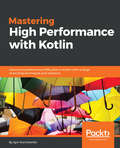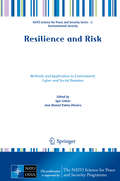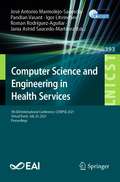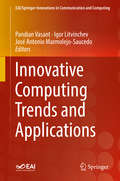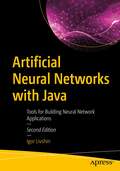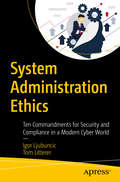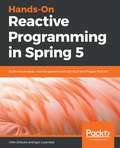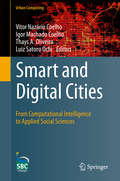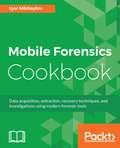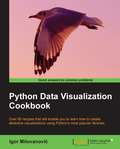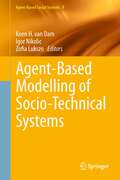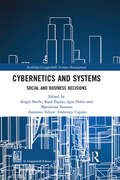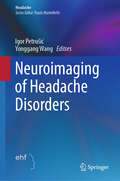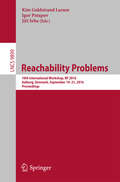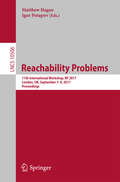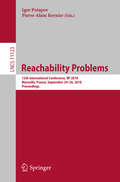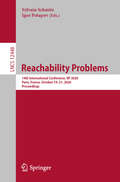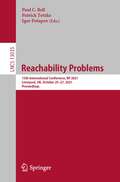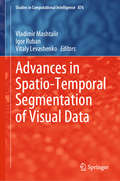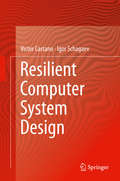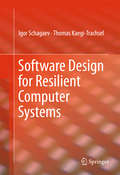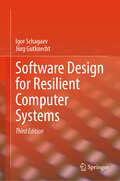- Table View
- List View
Mastering High Performance with Kotlin: Overcome performance difficulties in Kotlin with a range of exciting techniques and solutions
by Igor KucherenkoFind out how to write Kotlin code without overhead and how to use different profiling tools and bytecode viewer to inspect expressions of Kotlin language.Key Features Apply modern Kotlin features to speed up processing and implement highly efficient and reliable codes. Learn memory optimization, concurrency, multi-threading, scaling, and caching techniques to achieve high performance. Learn how to prevent unnecessary overhead and use profiling tools to detect performance issues. Book DescriptionThe ease with which we write applications has been increasing, but with it comes the need to address their performance. A balancing act between easily implementing complex applications and keeping their performance optimal is a present-day requirement In this book, we explore how to achieve this crucial balance, while developing and deploying applications with Kotlin.The book starts by analyzing various Kotlin specifcations to identify those that have a potentially adverse effect on performance. Then, we move on to monitor techniques that enable us to identify performance bottlenecks and optimize performance metrics. Next, we look at techniques that help to us achieve high performance: memory optimization, concurrency, multi threading, scaling, and caching. We also look at fault tolerance solutions and the importance of logging. We'll also cover best practices of Kotlin programming that will help you to improve the quality of your code base.By the end of the book, you will have gained some insight into various techniques and solutions that will help to create high-performance applications in the Kotlin environmentWhat you will learn Understand the importance of high performance Learn performance metrics Learn popular design patterns currently being used in Kotlin Understand how to apply modern Kotlin features to data processing Learn how to use profling tools Discover how to read bytecode Learn to perform memory optimizations Uncover approaches to the multithreading environmentWho this book is forThis book is for Kotlin developers who would like to build reliable and high-performance applications. Prior Kotlin programming knowledge is assumed.
Resilience and Risk
by Igor Linkov José Manuel Palma-OliveiraThis volume addresses the challenges associated with methodology and application of risk and resilience science and practice to address emerging threats in environmental, cyber, infrastructure and other domains. The book utilizes the collective expertise of scholars and experts in industry, government and academia in the new and emerging field of resilience in order to provide a more comprehensive and universal understanding of how resilience methodology can be applied in various disciplines and applications. This book advocates for a systems-driven view of resilience in applications ranging from cyber security to ecology to social action, and addresses resilience-based management in infrastructure, cyber, social domains and methodology and tools. Risk and Resilience has been written to open up a transparent dialog on resilience management for scientists and practitioners in all relevant academic disciplines and can be used as supplement in teaching risk assessment and management courses.
Computer Science and Engineering in Health Services: 5th EAI International Conference, COMPSE 2021, Virtual Event, July 29, 2021, Proceedings (Lecture Notes of the Institute for Computer Sciences, Social Informatics and Telecommunications Engineering #393)
by Pandian Vasant Igor Litvinchev José Antonio Marmolejo-Saucedo Roman Rodríguez-Aguilar Jania Astrid Saucedo-MartínezThis book constitutes the refereed post-conference proceedings of the 5th International Conference on Computer Science and Engineering in Health Services, COMPSE 2021, held in July 2021. Due to COVID-19 pandemic the conference was held virtually. The 17 full papers presented were carefully reviewed and selected from 46 submissions. The papers are grouped on thematic topics: application of tools delivered by the COVID-19 pandemic; health services; computer and data science; and industry 4.0 in logistics and supply chain.
Innovative Computing Trends and Applications (EAI/Springer Innovations in Communication and Computing)
by Pandian Vasant Igor Litvinchev José Antonio Marmolejo-SaucedoThis book provides a survey on research, development, and trends in innovative computing in communications engineering and computer science. It features selected and expanded papers from the EAI International Conference on Computer Science and Engineering 2018 (COMPSE 2018), with contributions by top global researchers and practitioners in the field. The content is of relevance to computer science graduates, researchers and academicians in computer science and engineering. The authors discuss new technologies in computer science and engineering that have reduced the dimension of data coverage worldwide, reducing the gaps and coverage of domains globally. They discuss how these advances have also contributed to strength in prediction, analysis, and decision in the areas such as Technology, Management, Social Computing, Green Computing, and Telecom. Contributions show how nurturing the research in technology and computing is essential to finding the right pattern in the ocean of data.Focuses on research areas of innovative computing and its application in engineering and technology;Includes contributions from researchers in computing and engineering from around the world;Features selected and expanded papers from EAI International Conference on Computer Science and Engineering 2018 (COMPSE 2018).
Artificial Neural Networks with Java: Tools for Building Neural Network Applications
by Igor LivshinDevelop neural network applications using the Java environment. After learning the rules involved in neural network processing, this second edition shows you how to manually process your first neural network example. The book covers the internals of front and back propagation and helps you understand the main principles of neural network processing. You also will learn how to prepare the data to be used in neural network development and you will be able to suggest various techniques of data preparation for many unconventional tasks. This book discusses the practical aspects of using Java for neural network processing. You will know how to use the Encog Java framework for processing large-scale neural network applications. Also covered is the use of neural networks for approximation of non-continuous functions. In addition to using neural networks for regression, this second edition shows you how to use neural networks for computer vision. It focuses on image recognition such as the classification of handwritten digits, input data preparation and conversion, and building the conversion program. And you will learn about topics related to the classification of handwritten digits such as network architecture, program code, programming logic, and execution. The step-by-step approach taken in the book includes plenty of examples, diagrams, and screenshots to help you grasp the concepts quickly and easily.What You Will LearnUse Java for the development of neural network applicationsPrepare data for many different tasksCarry out some unusual neural network processingUse a neural network to process non-continuous functionsDevelop a program that recognizes handwritten digitsWho This Book Is ForIntermediate machine learning and deep learning developers who are interested in switching to Java
System Administration Ethics: Ten Commandments for Security and Compliance in a Modern Cyber World
by Igor Ljubuncic Tom LittererSuccessfully navigate through the ever-changing world of technology and ethics and reconcile system administration principles for separation of duty, account segmentation, administrative groups and data protection. As security breaches become more common, businesses need to protect themselves when facing ethical dilemmas in today’s digital landscape. This book serves as a equitable guideline in helping system administrators, engineers – as well as their managers – on coping with the ethical challenges of technology and security in the modern data center by providing real-life stories, scenarios, and use cases from companies both large and small. You'll examine the problems and challenges that people working with customer data, security and system administration may face in the cyber world and review the boundaries and tools for remaining ethical in an environment where it is so easy to step over a line - intentionally or accidentally. You'll also see how to correctly deal with multiple ethical situations, problems that arise, and their potential consequences, with examples from both classic and DevOps-based environments.Using the appropriate rules of engagement, best policies and practices, and proactive “building/strengthening” behaviors, System Administration Ethics provides the necessary tools to securely run an ethically correct environment. What You'll LearnThe concepts of Least Privilege and Need to KnowRequest change approval and conduct change communicationFollow "Break Glass" emergency proceduresCode with data breaches, hacking and security violations, and proactively embrace and design for failures Build and gain trust with employees and build the right ethical cultureReview what managers can do to improve ethics and protect their employeesWho This Book Is ForThis book’s primary audience includes system administrators and information security specialists engaged with the creation, process and administration of security policies and systems. A secondary audience includes company leaders seeking to improve the security, privacy, and behavioral practices.
Hands-On Reactive Programming in Spring 5: Build cloud-ready, reactive systems with Spring 5 and Project Reactor
by Oleh Dokuka Igor LozynskyiExplore the reactive system and create efficient microservices with Spring Boot 2.1 and Spring CloudKey FeaturesUnderstand the kind of system modern businesses require with SpringGain deeper insights into reactive programming with Reactor and Spring CloudGet in-depth knowledge on asynchronous and nonblocking communication with Spring 5 WebFluxBook DescriptionThese days, businesses need a new type of system that can remain responsive at all times. This is achievable with reactive programming; however, the development of these kinds of systems is a complex task, requiring a deep understanding of the domain. In order to develop highly responsive systems, the developers of the Spring Framework came up with Project Reactor.Hands-On Reactive Programming in Spring 5 begins with the fundamentals of Spring Reactive programming. You’ll explore the endless possibilities of building efficient reactive systems with the Spring 5 Framework along with other tools such as WebFlux and Spring Boot. Further on, you’ll study reactive programming techniques and apply them to databases and cross-server communication. You will advance your skills in scaling up Spring Cloud Streams and run independent, high-performant reactive microservices.By the end of the book, you will be able to put your skills to use and get on board with the reactive revolution in Spring 5.1!What you will learnDiscover the difference between a reactive system and reactive programmingExplore the benefits of a reactive system and understand its applicationsGet to grips with using reactive programming in Spring 5Gain an understanding of Project ReactorBuild a reactive system using Spring 5 and Project ReactorCreate a highly efficient reactive microservice with Spring CloudTest, monitor, and release reactive applicationsWho this book is forThis book is for Java developers who use Spring to develop their applications and want to build robust and reactive applications that can scale in the cloud. Basic knowledge of distributed systems and asynchronous programming will help you understand the concepts covered in this book.
Smart and Digital Cities: From Computational Intelligence to Applied Social Sciences (Urban Computing)
by Vitor Nazário Coelho Igor Machado Coelho Thays A. Oliveira Luiz Satoru OchiThis book presents up-to-date information on the future digital and smart cities. In particular, it describes novel insights about the use of computational intelligence techniques and decentralized technologies, covering urban aspects and services, cities governance and social sciences. The topics covered here range from state-of-the-art computational techniques to current discussions regarding drones, blockchain, smart contracts and cryptocurrencies.The idealization of this material emerged with a journey of free knowledge exchange from a diverse group of authors, who met each other through four different events (workshops and special sessions) organized with the purpose of boosting the concepts surrounding smart cities.We believe that this book comprises innovative and precise information regarding state-of-the-art applications and ideas for the future of cities and society. It will surely be useful not only for the academic community but also to the industry professionals and city managers.
Mobile Forensics Cookbook
by Igor MikhaylovDiscover the tools and techniques of mobile forensic investigations and make sure your mobile autopsy doesn't miss a thing, all through powerful practical recipes About This Book • Acquire in-depth knowledge of mobile device acquisition using modern forensic tools • Understand the importance of clouds for mobile forensics and learn how to extract data from them • Discover advanced data extraction techniques that will help you to solve forensic tasks and challenges Who This Book Is For This book is aimed at practicing digital forensics analysts and information security professionals familiar with performing basic forensic investigations on mobile device operating systems namely Android, iOS, Windows, and Blackberry. It's also for those who need to broaden their skillset by adding more data extraction and recovery techniques. What You Will Learn • Retrieve mobile data using modern forensic tools • Work with Oxygen Forensics for Android devices acquisition • Perform a deep dive analysis of iOS, Android, Windows, and BlackBerry Phone file systems • Understand the importance of cloud in mobile forensics and extract data from the cloud using different tools • Learn the application of SQLite and Plists Forensics and parse data with digital forensics tools • Perform forensic investigation on iOS, Android, Windows, and BlackBerry mobile devices • Extract data both from working and damaged mobile devices using JTAG and Chip-off Techniques In Detail Considering the emerging use of mobile phones, there is a growing need for mobile forensics. Mobile forensics focuses specifically on performing forensic examinations of mobile devices, which involves extracting, recovering and analyzing data for the purposes of information security, criminal and civil investigations, and internal investigations. Mobile Forensics Cookbook starts by explaining SIM cards acquisition and analysis using modern forensics tools. You will discover the different software solutions that enable digital forensic examiners to quickly and easily acquire forensic images. You will also learn about forensics analysis and acquisition on Android, iOS, Windows Mobile, and BlackBerry devices. Next, you will understand the importance of cloud computing in the world of mobile forensics and understand different techniques available to extract data from the cloud. Going through the fundamentals of SQLite and Plists Forensics, you will learn how to extract forensic artifacts from these sources with appropriate tools. By the end of this book, you will be well versed with the advanced mobile forensics techniques that will help you perform the complete forensic acquisition and analysis of user data stored in different devices. Style and approach This book delivers a series of extra techniques and methods for extracting and analyzing data from your Android, iOS, Windows, and Blackberry devices. Using practical recipes, you will be introduced to a lot of modern forensics tools for performing effective mobile forensics.
Python Data Visualization Cookbook
by Igor MilovanovicThis book is written in a Cookbook style targeted towards an advanced audience. It covers the advanced topics of data visualization in Python.Python Data Visualization Cookbook is for developers that already know about Python programming in general. If you have heard about data visualization but you don't know where to start, then this book will guide you from the start and help you understand data, data formats, data visualization, and how to use Python to visualize data.You will need to know some general programming concepts, and any kind of programming experience will be helpful, but the code in this book is explained almost line by line. You don't need maths for this book, every concept that is introduced is thoroughly explained in plain English, and references are available for further interest in the topic.
Agent-Based Modelling of Socio-Technical Systems (Agent-Based Social Systems #9)
by Zofia Lukszo Koen H. Dam Igor NikolicDecision makers in large scale interconnected network systems require simulation models for decision support. The behaviour of these systems is determined by many actors, situated in a dynamic, multi-actor, multi-objective and multi-level environment. How can such systems be modelled and how can the socio-technical complexity be captured? Agent-based modelling is a proven approach to handle this challenge. This book provides a practical introduction to agent-based modelling of socio-technical systems, based on a methodology that has been developed at TU Delft and which has been deployed in a large number of case studies. The book consists of two parts: the first presents the background, theory and methodology as well as practical guidelines and procedures for building models. In the second part this theory is applied to a number of case studies, where for each model the development steps are presented extensively, preparing the reader for creating own models.
Cybernetics and Systems: Social and Business Decisions (Routledge-Giappichelli Systems Management)
by Raul Espejo Sergio Barile Igor Perko Marialuisa SavianoSociety is now facing challenges for which the traditional management toolbox is increasingly inadequate. Well-grounded theoretical frameworks, such as systems thinking and cybernetics, offer general level interpretation schemes and models that are capable of supporting understanding of complex phenomena and are not impacted by the passage of time. This book serves the knowledge society to address the complexity of decision making and problem solving in the 21st century with contributions from systems and cybernetics. A multi-disciplinary approach has been adopted to support diversity and to develop inter- and trans-disciplinary knowledge within the shared thematic of problem solving and decision making in the 21st century. Its conceptual thread is cyber/systemic thinking, and its realisation is supported by a wide network of scientists on the basis of a highly participative agenda. The book provides a platform of knowledge sharing and conceptual frameworks developed with multi-disciplinary perspectives, which are useful to better understand the fast changing scenario and the complexity of problem solving in the present time.
Neuroimaging of Headache Disorders (Headache)
by Igor Petrušić Yonggang WangThis book offers a comprehensive overview of structural and functional neuroimaging findings related to the pathophysiology of primary and secondary headaches. In addition, it provides recommendations for best practice and decision-making in ordering neuroimaging investigation when faced with patients suffering from a vast range of headache types, whether in everyday practice, or in an ambulance or emergency room. Hopefully, this book will promote the adequate use of cutting-edge neuroimaging in headache research and in ongoing clinical trials in major neurology centers in Europe and worldwide. The structure of the book is designed to cover the basic principles of neuroimaging that neurologists should be aware of when making decisions about headache management, scientifically based recommendations for the application of different neuroimaging protocols in the emergency department and in the neurological clinic, the latest findings from advanced neuroimaging related to migraine without and with aura, chronic migraine and medication overuse headache, cluster headache, trigeminal neuralgia and other forms of headache and orofacial pain. Finally, the book contains a chapter on future directions in headache neuroimaging and the implementation of machine and deep learning algorithms in the neuroimaging and classification of headaches and the prediction of treatment outcomes. Neurologists, radiologists and physicians involved in pain medicine will benefit from this book, by having access to comprehensive, state-of-the-art knowledge on research and clinical practice in the field of headache neuroimaging. Furthermore, it could be a compendium for medical students and residents who are usually introduced to headache neuroimaging through multidisciplinary university programmes. Headache patients will also benefit from this book, being helped to better understand their condition from a neuroimaging techniques perspective.
Reachability Problems
by Kim Guldstrand Larsen Igor Potapov Jiří SrbaThis book constitutes the proceedings of the 8th International Workshop on Reachability Problems, RP 2014, held in Oxford, UK, in September 2014. The 17 papers presented in this volume were carefully reviewed and selected from 25 submissions. The book also contains a paper summarizing the invited talk. The papers offer new approaches for the modelling and analysis of computational processes by combining mathematical, algorithmic, and computational techniques.
Reachability Problems
by Igor Potapov Matthew HagueThis book constitutes the refereed proceedings of the 11th International Workshop on Reachability Problems, RP 2017, held in London, UK, in September 2017. The 12 full papers presented together with 1 invited paper were carefully reviewed and selected from 17 submissions. The aim of the conference is to bring together scholars from diverse fields with a shared interest in reachability problems, and to promote the exploration of new approaches for the modelling and analysis of computational processes by combining mathematical, algorithmic, and computational techniques. Topics of interest include (but are not limited to): reachability for innite state systems; rewriting systems; reachability analysis in counter/timed/cellular/communicating automata; Petri nets; computational aspects of semigroups, groups, and rings; reachability in dynamical and hybrid systems; frontiers between decidable and undecidable reachability problems; complexity and decidability aspects; predictability in iterative maps, and new computational paradigms.
Reachability Problems: 12th International Conference, RP 2018, Marseille, France, September 24-26, 2018, Proceedings (Lecture Notes in Computer Science #11123)
by Igor Potapov Pierre-Alain ReynierThis book constitutes the refereed proceedings of the 12th International Conference on Reachability Problems, RP 2018, held in Marseille, France, in September 2018.The 11 full papers presented were carefully reviewed and selected from 21 submissions. The papers cover topics such as reachability for infinite state systems; rewriting systems; reachability analysis in counter/timed/cellular/communicating automata; Petri nets; computational aspects of semigroups, groups, and rings; reachability in dynamical and hybrid systems; frontiers between decidable and undecidable reachability problems; complexity and decidability aspects; predictability in iterative maps, and new computational paradigms.
Reachability Problems: 14th International Conference, RP 2020, Paris, France, October 19–21, 2020, Proceedings (Lecture Notes in Computer Science #12448)
by Igor Potapov Sylvain SchmitzThis book constitutes the refereed proceedings of the 14th International Conference on Reachability Problems, RP 2020, held in Paris, France in October 2020.The 8 full papers presented were carefully reviewed and selected from 25 submissions. In addition, 2 invited papers were included in this volume. The papers cover topics such as reachability for infinite state systems; rewriting systems; reachability analysis in counter/timed/cellular/communicating automata; Petri nets; computational aspects of semigroups, groups, and rings; reachability in dynamical and hybrid systems; frontiers between decidable and undecidable reachability problems; complexity and decidability aspects; predictability in iterative maps; and new computational paradigms.
Reachability Problems: 15th International Conference, RP 2021, Liverpool, UK, October 25–27, 2021, Proceedings (Lecture Notes in Computer Science #13035)
by Igor Potapov Paul C. Bell Patrick TotzkeThis book constitutes the refereed proceedings of the 15th International Conference on Reachability Problems, RP 2021, held in Liverpool, UK in October 2021. The 6 full papers presented were carefully reviewed and selected from 27 submissions. In addition, 4 invited papers were included in this volume. The RP proceedings cover topics such as reachability for infinite state systems; rewriting systems; reachability analysis in counter/timed/cellular/communicating automata; Petri nets; computational aspects of semigroups, groups, and rings; reachability in dynamical and hybrid systems; frontiers between decidable and undecidable reachability problems; complexity and decidability aspects; predictability in iterative maps; and new computational paradigms. Chapter ‘Recent Advances on Reachability Problems for Valence Systems’ is available open access under a Creative Commons Attribution 4.0 International License via link.springer.com.
Advances in Spatio-Temporal Segmentation of Visual Data (Studies in Computational Intelligence #876)
by Vladimir Mashtalir Igor Ruban Vitaly LevashenkoThis book proposes a number of promising models and methods for adaptive segmentation, swarm partition, permissible segmentation, and transform properties, as well as techniques for spatio-temporal video segmentation and interpretation, online fuzzy clustering of data streams, and fuzzy systems for information retrieval. The main focus is on the spatio-temporal segmentation of visual information. Sets of meaningful and manageable image or video parts, defined by visual interest or attention to higher-level semantic issues, are often vital to the efficient and effective processing and interpretation of viewable information. Developing robust methods for spatial and temporal partition represents a key challenge in computer vision and computational intelligence as a whole.This book is intended for students and researchers in the fields of machine learning and artificial intelligence, especially those whose work involves image processing and recognition, video parsing, and content-based image/video retrieval.
Resilient Computer System Design
by Igor Schagaev Victor CastanoThis book presents a paradigm for designing new generation resilient and evolving computer systems, including their key concepts, elements of supportive theory, methods of analysis and synthesis of ICT with new properties of evolving functioning, as well as implementation schemes and their prototyping. The book explains why new ICT applications require a complete redesign of computer systems to address challenges of extreme reliability, high performance, and power efficiency. The authors present a comprehensive treatment for designing the next generation of computers, especially addressing safety critical, autonomous, real time, military, banking, and wearable health care systems.
Resilient computer system design
by Igor Schagaev Victor CastanoThis book presents a paradigm for designing new generation resilient and evolving computer systems, including their key concepts, elements of supportive theory, methods of analysis and synthesis of ICT with new properties of evolving functioning, as well as implementation schemes and their prototyping. The book explains why new ICT applications require a complete redesign of computer systems to address challenges of extreme reliability, high performance, and power efficiency. The authors present a comprehensive treatment for designing the next generation of computers, especially addressing safety critical, autonomous, real time, military, banking, and wearable health care systems.
Software Design for Resilient Computer Systems
by Igor Schagaev Thomas Kaegi-TrachselThis book addresses the question of how system software should be designed to account for faults, and which fault tolerance features it should provide for highest reliability. The authors first show how the system software interacts with the hardware to tolerate faults. They analyze and further develop the theory of fault tolerance to understand the different ways to increase the reliability of a system, with special attention on the role of system software in this process. They further develop the general algorithm of fault tolerance (GAFT) with its three main processes: hardware checking, preparation for recovery, and the recovery procedure. For each of the three processes, they analyze the requirements and properties theoretically and give possible implementation scenarios and system software support required. Based on the theoretical results, the authors derive an Oberon-based programming language with direct support of the three processes of GAFT. In the last part of this book, they introduce a simulator, using it as a proof of concept implementation of a novel fault tolerant processor architecture (ERRIC) and its newly developed runtime system feature-wise and performance-wise. The content applies to industries such as military, aviation, intensive health care, industrial control, space exploration, etc.
Software Design for Resilient Computer Systems
by Igor Schagaev Jürg GutknechtThis book addresses the question of how system software should be designed to account for faults, and which fault tolerance features should provide for highest reliability. With this third edition of Software Design for Resilient Computer Systems, the book is thoroughly updated to contain the newest advice regarding software resilience. With a new introductory chapter, the new edition is ideal for researchers and industry professionals. In the book, the authors first show how system software interacts with the hardware to tolerate faults. They analyze and further develop the theory of fault tolerance to understand the diverse ways to increase the reliability of a system, with special attention on the role of system software in this process. They introduce the theory of redundancy and its use for construction of a subsystem through generalised algorithm of fault tolerance (GAFT) and apply it to distributed systems. The book’s approach is applied to various hardware subsystems: different structures of RAM and processor cores and demonstrates exceptional performance reliability and energy efficiency. This third edition devotes substantial attention to system software for modern computers, including run time systems, supporting algorithms of recovery and their analysis, language aspects and ways to improve reconfigurable and parallel computing. Due to the wide-reaching nature of the content, this book applies to a host of industries and research areas, including military, aviation, intensive health care, industrial control, and space exploration.
Targeting Uplift: An Introduction to Net Scores
by René Michel Igor Schnakenburg Tobias von MartensThis book explores all relevant aspects of net scoring, also known as uplift modeling: a data mining approach used to analyze and predict the effects of a given treatment on a desired target variable for an individual observation. After discussing modern net score modeling methods, data preparation, and the assessment of uplift models, the book investigates software implementations and real-world scenarios. Focusing on the application of theoretical results and on practical issues of uplift modeling, it also includes a dedicated chapter on software solutions in SAS, R, Spectrum Miner, and KNIME, which compares the respective tools. This book also presents the applications of net scoring in various contexts, e.g. medical treatment, with a special emphasis on direct marketing and corresponding business cases. The target audience primarily includes data scientists, especially researchers and practitioners in predictive modeling and scoring, mainly, but not exclusively, in the marketing context.
Dynamic Logic. New Trends and Applications: Third International Workshop, DaLí 2020, Prague, Czech Republic, October 9–10, 2020, Revised Selected Papers (Lecture Notes in Computer Science #12569)
by Manuel A. Martins Igor SedlárThis book constitutes the proceedings of the Third International Workshop on Dynamic Logic, DaLí 2019, held in Prague, Czech Republic in October 2020. Due to COVID-19 the workshop has been held online. The 17 full papers presented together with 6 short papers were carefully reviewed and selected from 31 submissions. The theoretical relevance and practical potential of dynamic logic is a topic of interest in a number of scientific venues, from wide-scope software engineering conferences to modal logic specific events. The DaLí 2020 workshop is exclusively dedicated to Dynamic logic and aims at filling this gap and creating a heterogeneous community of colleagues, from Academia to Industry, from Mathematics to Computer Science.
